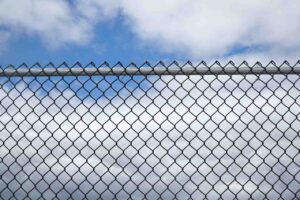Can You Paint a Chain Link Fence?
Have you ever looked at your chain link fence and wondered how you can make it look more aesthetically pleasing? “Can You Paint a Chain Link Fence? – yes, you can,
When you have your chain link fence painted professionally or as a DIY project, a fresh new layer of paint can breathe new life into your outdoor space, converting it into an inviting and aesthetically pleasing area on your property. From the essential preparation steps to selecting the right paint, extending the life of your painted fence, and adding your own personal touch, we’ll guide you through the entire process through this blog.
Can You Paint a Chain Link Fence?
Most chain link fences, primarily constructed from galvanized steel, face years of exposure to the elements like rain, wind, snow, and temperature extremes. So, can you paint a chain link fence? Yes—especially when a chain link fence shows signs of wear and tear. It’s a practical way to extend your chain link fence’s lifespan.
Can You Paint a Rusty Chain Link Fence?
Yes you can paint a rusty chain link fence. Make sure to replace fence parts disintegrating from rust. Pay special attention to rusted fence posts with holes or thin spots, as they could compromise the structure. Grab a wire brush and get hands-on to make your fence rust-free again. Go around the fence, brushing the poles and sides of that chain-link enclosure.
When dealing with stubborn rust, get your hands on some rust-stopping spray like your go-to WD-40 spray . You can usually find these sprays at your local hardware store. Make sure to follow the manufacturer’s instructions for the best results.
Preparing Your Chain Link Fence for Painting
When you’re painting a chain-link fence, the key here is to ensure you’ve prepared the surface correctly. Neglecting this crucial step will most likely lead to issues like flaking paint, early paint deterioration from weathering, and increased rust down the road. As long as you prepare your fence correctly before painting, you should not have any issues.
Before diving into the painting process, remember that assessing your fence’s condition is essential. Here are the steps you should take:
Step 1: Inspect for Damage
Carefully examine your fence first. Make a checklist of any missing wires, loose posts, broken links, or bent rails that require repair. Remember to check your gates for loose hinges, bent frames, or broken latches.
Step 2: Evaluate Previous Coatings
If your fence has been painted before, take the time to remove any loose paint using a wire brush or a pressure washer. This step ensures a clean and smooth surface for your new paint application.
Step 3: Wash Away All the Debris
Give that fence a good cleaning. Start by removing cobwebs, leaves, and grass. Give the whole fence a good spray if you’ve got a hose. If not, no worries – just grab a bucket and a sponge and scrub both sides of the fence and the poles. If there’s old paint on there, a pressure washer will help blast it away. Just remember to let the fence dry entirely afterward.
Choosing the Right Paint: Can You Spray Paint a Chain Link Fence?

What really works best for chain link fences? The easy answer is you can spray paint a chain link fence. When it’s time to paint your chain link fence, using a brush and roller can be quite slow and labor-intensive. They’re handy for minor touch-ups or small sections, but a paint sprayer is your best bet if you’re taking on the entire fence.
Your decision here really comes down to the state of your fence. If it’s in excellent condition, you can stick with an acrylic direct-to-metal (DTM) paint – that’s all you’ll need.
You can also opt for an oil-based paint that offers rust protection. Look out for outdoor paints with aluminum flakes. These tiny flakes in the paint come together to form a strong, water-resistant bond, ensuring your paint job stands the test of time.
How Long Does a Painted Chain Link Fence Last?
Taking good care of your chain link fence can stand tall and sturdy for over twenty years. The great news is that maintaining it can be a manageable amount of effort.
Here are some smart practices to consider to ensure your chain link fence remains in excellent shape for years.
Regular Cleaning
Regular cleaning is a must. A quick wash with water can remove light dirt, while dish soap helps tackle stubborn stains like bird droppings. Use a high-powered hose setting for easy cleanup or grab a cotton towel or scrub brush for tougher spots.
Regular Repairs
Pay close attention to the connections to posts, as they are prone to wear and tear. Loose connections and chain link segments pulling away from posts can occur over time. If you notice sagging gates or unevenness due to frequent use, check for loose hinges or missing bolts and make repairs as needed.
Avoid Climbing on the Fence
Avoid climbing on the chain link at all costs. Climbing can bend support posts and weaken the entire fence. Ensure your children and pets don’t attempt to climb by either adding vinyl slats or removing any potential aids like cinder blocks, logs, or ladders near the fence.
Applying Rust Protection
Yearly rust protection is a must. Spray a rust-resistant coating on your chain link fence, paying extra attention to the bottom where moisture accumulates. If you spot any existing rust, contact a fencing expert for prompt repairs; neglecting rust can weaken your fence over time.
Don’t Grow Plants on the Fence
While adding decorative plants to your fence might seem tempting, it’s best to avoid it. Plants can grow through the chain link, potentially damaging it. Keep an eye out for unwanted tree seedlings near your fence and remove them promptly.
Step-by-Step Painting Process: How to Achieve a Professional Finish

Step 1: Prepare for Priming
Giving your chain link fence a good start by priming is key to making your paint job truly shine. If you notice rust or an old coat of paint, apply a layer of metal primer. You can easily find this at your local hardware store. But you can skip the primer if your fence is brand new or in excellent condition. Remember, priming ensures a solid base for your paint, and it’s your secret to achieving a fantastic result.
Step 2: Set a Cardboard Against the Bottom Fence
Make your job easier by placing a sizable cardboard sheet on the ground right up against the fence’s bottom. Then, use the cardboard to press down the grass beneath the fence, allowing you to reach and paint that lower part with minimal hassle, and at the same time, this doesn’t stain your grass with the paint. This trick puts you in control and makes the task much more efficient to finish.
Step 3: Applying the Spray Paint the Right Way
To get started, fill the sprayer cup with paint (thinned according to the manufacturer’s guidelines), plug it in, and simply pull the trigger to maintain a continuous spray. You can refine your technique by practicing on a scrap board, allowing you to adjust the nozzle opening for your preferred spray flow.
When it’s time to paint your fence, position the sprayer about 12 to 14 inches from the surface and begin working from the top, moving side to side. Maintain a continuous, slightly overlapping spray pattern to ensure a uniform coat across all parts of the fence. To prevent drips, avoid lingering in one spot for more than a second or two.
Repeat this process on both sides of the fence, ensuring thorough coverage of all post sides and the undersides of the top rails.
Pro Tip: Applying just one coat will offer ample coverage, yet opting for two coats enhances the durability and protection of your fence. Even if you decide on a single coat for the fence, it’s wise to go with two coats on gates and gate posts exposed to greater wear and tear. This extra layer ensures their longevity and strength.
Step 4: Let All the Paint Dry
Don’t rush the final step – letting the paint thoroughly dry is crucial. After you’ve completed your painting task, be patient and allow the paint to dry completely. Make sure nothing touches the wet paint. This patience is the key to achieving a flawless finish and ensuring your hard work stands test of time



